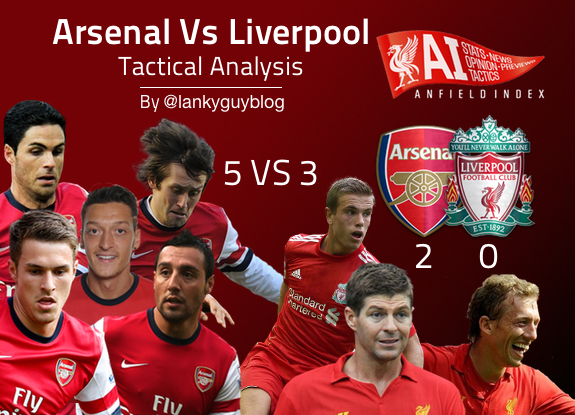 Arsenal for their part started in their usual 4-2-3-1 shape. Arteta and Ramsey started as the holding midfielders, although Ramsey didn’t particularly play as a holding player, preferring to get forward and combine with Cazorla, Ozil, Rosicky and the lone striker Giroud. This was at risk of leaving Arteta isolated on transition defence.
Arsenal for their part started in their usual 4-2-3-1 shape. Arteta and Ramsey started as the holding midfielders, although Ramsey didn’t particularly play as a holding player, preferring to get forward and combine with Cazorla, Ozil, Rosicky and the lone striker Giroud. This was at risk of leaving Arteta isolated on transition defence.
Liverpool continued with their 3-5-2, keeping the same midfield shape as they did last week against West Brom with Lucas as the pivot just in front of the back three, with Gerrard and Henderson in front of him in a ‘1-2’ triangle. Cissokho played left-wing back and Flanagan made a surprise start on the other side, coming in for Glen Johnson who had to go to hospital with a face infection. Suarez and Sturridge started up front as usual.
Shape and roles of the three centre backs
Before moving onto the game dynamics and the systems match up, it’s important to look at the recent back line shape from Liverpool. Of course, playing with three centre backs and two wing backs requires different movements and coordination than a normal back four does. It requires different responses when the opponent has the ball, different responsibilities and roles within the defensive shape.
With the current set up of three CBs, there are two roles within it. One is that of the outside or lateral centre backs, Toure and Sakho. The other is that of the middle centre back, Skrtel. A quick look at the average positions from the game partly shows us this.
Liverpool’s average positions are on the right. The change of shape in the second half has slightly skewed them but even then it is clear to see that Toure (number 4) and Sakho (number 17) are fairly high, roughly along the same line. Skrtel (number 37) is positioned clearly deeper, although slightly to the left due to his change to left-sided centre back when Rodgers shifted to a back four in the second half.
Clearly, such a positional difference means different roles within the system. In possession, Toure and Sakho have to push wider, supporting the wing backs, stretching the pitch and even be willing, more in Sakho’s case, to get forward and overlap with the wing back.When the team is out of possession, they, as the outside defenders, have to play more aggressively on the front foot, stepping up to close down and mark between the lines, trying to win the ball in that area.
Skrtel’s role defensively is somewhat different. He covers behind when Toure or Sakho step out, guarding any runs in that space, sweeping any balls played through or in the air. In effect, he plays as a sweeper.
This role suits him in many ways. He doesn’t have to push up and be aggressive 1 v 1 against players moving between the lines, he is less likely to get caught out for pace because he can stay behind, often deeper than the outside centre backs and he faces more balls in the air from his lower position

In this match it has to be said that Skrtel put in another efficient performance. He did his job, covering well from behind, winning aerial balls over the top, tracking Giroud’s runs behind. At the moment he arguably looks one of Liverpool’s best players and it cannot be underestimated how much of that is down to the role Rodgers has given him within the team, a role where his skill-set is best put to use and his weaknesses are less exposed.
How Arsenal exploited Liverpool’s system
It would be wrong to say that Liverpool played poorly in this game. Certain aspects of the team’s play worked well in different parts and despite the fact that Arsenal were obviously the better side and were a level above on the day, Liverpool still played to a decent level.
Having said that, certain areas of weakness within the current system were highlighted throughout the first half.
The first step to understanding these are to understand how Arsenal were playing and the quality of their personnel. Arsenal’s obvious strength is in their passing quality, their ability to combine with each other, playing short passes at a high-speed and to control and create chances through this. With Arteta, Ramsey, Cazorla, Ozil and Rosicky in midfield, Arsenal had plenty of talent in ball control and retention, fluidity, ability to combine lines through the phases of possession and to use and create space within Liverpool’s defensive system.
Another look at the average positions shows how close together their midfield and attacking players played together.
What was obvious even from the line up was that Arsenal don’t particularly attack with much width. That’s not to say they don’t use the wide areas – they absolutely do as will be touched on in a second. But their penetration doesn’t generally come from attacking using flank play. If it does, it’s generally on counter attacks where there is more space.
However what was interesting looking at the percentages of where attacks came from was that just 24% of Arsenal’s attacks came through the middle. 36% came down the left, 41% came down the right.

If Arsenal’s attacking players were playing so narrow and close together, why did it seem that they were barely playing through the middle and attacking so much in the wide areas? To provide context as to the reason for this, you simply need to study Liverpool’s system.
When teams play a 4-2-3-1 or a 4-3-3, quite often it is talked about how they are playing with three in midfield. This match up has often been mentioned in reference to gaining dominance or control in midfield through numerical superiority or at least equality. However this negates part of the issue, especially when talking about the defensive phase. For example a 4-2-3-1/4-4-1-1 may have three midfielders in the middle to try and control space and limit the ability to link play in the middle. However, because it also has two layers of width (the full backs and the wingers in front), it also has extra support in controlling that crucial central space – for example, wingers are able to ‘pinch in’ knowing they have the full backs behind them should play be progressed down the flank.
One of the main aspects of the 3-5-2 is that there is only one layer of width – the wing backs. Many people assume that this means you can get overloads against the wing backs 2 v 1. If played correctly, this isn’t necessarily the case – if a team tries to attack down the side with two players, the wing back only needs to step out and the outside centre back come across and you can deal with such a scenario comfortably.
However because the wing backs are generally the only layer of width in a 3-5-2 and largely control the flank, it makes it difficult for them to ever ‘pinch in’ as wingers may do in an orthodox system with four at the back.
Let’s have a look at this example below:
Rosicky has the ball in space. First of all, it is too far out for Sakho to go – he is already marking Cazorla and Giroud is making a run behind him so he can’t just rush out. Cissokho is marking Sagna in the wide area. He cannot tuck in and put pressure on Rosicky because he is the only player on that side marking the flank and he would just leave Sagna with a lot of space behind if he went to Rosicky. It is therefore left to Gerrard to try to get across.
This is the type of situation that Arsenal had space and time in throughout the first half. When play is switched and the full back has made a run to attract the wing back, it is left to the midfield to get across horizontally as quickly as possible. This leaves them exposed and having to work hard in order to shift across laterally. This is why Arsenal were attacking the wide zones on the stats and these were the little areas where they were constantly able to find space and to retain possession.
Next Page: What other moves exploited the weaknesses in Liverpool’s system? Read more…









Top article Jonny – great start on AI!
Excellent analysis.
One of the best I’ve read on this match, keep it up.
Gr8 analysis.
There’s a huge flaw with the defensive organization. Notice Flannagan’s positioning in the image where you talk about Rosicky in space.
Ideally in a 5 man defense, when the ball is on one side of the pitch, the wing back is usually out of line and pressing ahead. the wingback on the opp side, should compensate by dropping deeper and making it a 4 man defense that’s pressing horizontally and closing down the gaps.
Both defense and the midfield lines should oscillate. LFC players have yet to develop that sort of an understanding. Cant say if it is BR’s fault or if the player’s have failed to implement it well.
However, much of the failure of our 3 man midfield against Arsenal’s 5 should be attributed to our 2 front men not dropping deep enough.
They should drop deeper when the ball’s in the middle of the park so as to pressure opposition’s midfield. However, push ahead when the ball is near our box, so that they can alienate opposition’s CBs.
3-5-2 is not a failure. Its a combination of a lack of understanding and wrong players in right positions that has culminated in a dross showing.